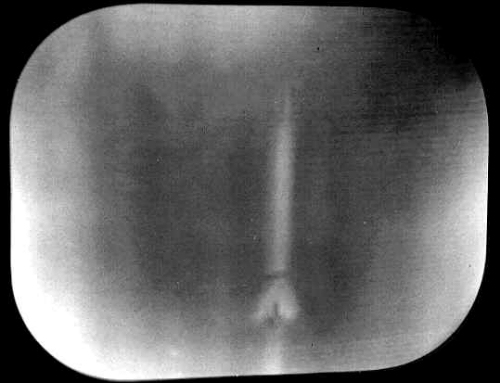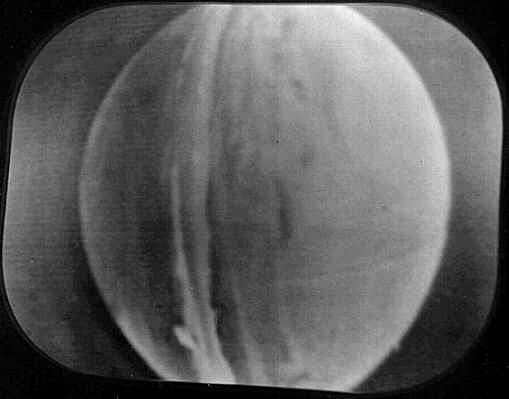
There are 3 photos that were actually taken off the air in 1951 from WPTZ, Channel 3 in Philadelphia. Scroll down completely to see all pictures and read all the text.

(Left to right) Rocket Expert Bill Bergen & Newsman Roy Neal
WPTZ, Channel 3 in Philadelphia
1951
![]()
It was Bill Bergen, who was in charge of rocket testing for the Martin Company. Bergen went on to Rockwell, in later years, where he was prominent in mounting the spacecraft that sent men to the moon.
At the time of this coverage, he was launching V-2 adaptations from the German rocket program at White Sands, NM and some designed by the Martin Company. He had the foresight to put a camera on board and it sent back some of the first pix of earth as seen from space. We showed them on TV....
All that happened circa ...1951. We carried the aerospace theme even farther on our "Open House" show by doing a series on what H bombs would do from orbital altitude. Dr I. M. Levitt, who took over Fels Planetarium from Roy Marshall, drafted illustrations so accurate that years later, when the U.S. detonated an H bomb, his overlays matched those of the real test!
A national publication wrote about "Open House." They said:
Roy Neal's popular program brings both the obscure and the famous to television.
When that famous door opens each Wednesday night at 7 P.M. on Channel 3, "Open House" fans go through an emotion similar to that of opening a gift package. They never know what's going to be there, but there's always that keen sense of anticipation.
"Open House" is like that. You don't know what's in store for you, but you do know that what is there will be a pleasant half-hour of televiewing.
For people like Duke Ellington might show up to do a few piano numbers. Or Andy Varipapa, bowling champion might demonstrate his style. Magician Blackwell might do some of his famous feats, or Vic Damone might do a few songs.
"Open House" has entertained the unheard-ofs as well as the famous. Obscure people, but ones who do interesting jobs or have a fascinating story to tell, keep popping on this modest little show which offers just a swift change of pace from jugglers to dancers to cartoonists; from stars of stage and screen to museum curates and political greats.
Tall, blonde Roy Neal, the pleasing host of "Open House" has a flair for getting the most out of his guests. The fact that they produce solid entertainment, coming as they do from every walk of life and every kind of pursuit, is a tribute to his pleasing personality and ability to make them feel at home.
Roy Neal conceived "Open House" modestly admitting that "there was nothing new about the idea, but it hadn't been used before on TV." Originally titled "Please to Meet You," it was televised before "We, the People," which uses the same format.
Unassuming as it may appear, "Open House" has a lot of other "firsts" tucked under its belt. The program had given TV debuts to such personalities as sportscaster Stoney McLinn, Clown Emmett Kelly and Eagles football player Bosh Pritchard. Popular singer Vic Damone made his first TV appearance on this program and later had his nose bobbed for other TV appearances.
Others which have highlighted the program with personal appearances include playwright Robert Sherwood, Cab Calloway, June Christie, Patti Page, Ray and Bob Eberly, screen star Lloyd Nolan, heavyweight crown contender Jersey Joe Walcott, Gen. George Marshall, singing star Bill Farrell, Maxie Baer and "Slapsie" Max Rosenbloom.
Yes, Roy Neal has been genial host for lots of distinguished company.
Neal has been a radio announcer and news editor. He entered the U.S. Army as a private in 1944, was commissioned and shipped to Germany, where he managed motion picture houses and Special Service shows. He later became production director for the Armed Forces Network, which had stations in Paris, Berlin and other European cities. His staff there included movie stars Mickey Rooney and Tom Brown.
In July of 1947, another national publication wrote about "Pleased to Meet You" which was the forerunner of "Open House." The article said:
Thursday, 8-8:20 p.m. Sustaining over WPTZ (Philco), Philadelphia.
Radio's familiar pattern of across-the-mike interviews with personalities is transplanted to the video studio with a high degree of effectiveness in this weekly "Pleased to Meet You" visit. Much measure of the show's success belongs to Roy Neal, mike regular at WIBG here, who brings to the television camera a pleasant personality and an air of informality that makes him a most welcome visitor into your home parlor. Moreover, Neal displays a fine gift of conversational gab, with voice and diction to blend in a manner that makes the onlooker feel like more of an insider.
Handshakes across a blow-up of the familiar city landmark of William Penn's statue atop the City Hall set the informal stage for the show. Projecting his personality on the cathode tube, Neal established friendly relationships with both the viewers and studio visitors from scratch and it's all the more to his credit that he generates an even flow of conversation without dominating it. For the 20 minutes, he brought four different persons before the camera, taking each on for about five minutes, and maintained a swift pace that made the visit end all too soon.
Neal eschews the dribble associated with most mike interviews and gets right into the meat of the subject matter. And avoiding question-and-answer triteness, he makes it a running conversation. When caught, he presented four diverse and topical subjects. He started off on a serious note, inviting the area rent director to sit beside him in an easy chair to discuss the provision of the new federal rent bill. He followed with last year's contestant for the Miss Greater Philadelphia (Ginny Brown), who is coaching this year's contestants for the Miss America beauty pageant. The two assuming a standing position, the gal was able to demonstrate how a queen must strut before the judges.
Back to the easy chairs, Neal next brought on Cy Peterman, war correspondent for the Philadelphia Inquirer just back from a roving assignment across the pond. He talked about his recent junket to Russia without getting into any heavy controversy, and ended with a timely piece on the significance of Independence Day. And again contrasting the subjects and subject matter, Neal polished off with the general manager of the local bubble gum outfit, telling about the "blowing bubbles" contest to be held at the park the next day. He took time out to synchronize his facial muscles with the off-stage recording of Spike Jones' bubble gum song, polishing off with two kids coming in to blow giant bubbles.

U. S. Viking 7 Rocket Takes Off
WPTZ, Channel 3 in Philadelphia
August 7, 1951
The V-2 was originally developed by the Germans during WWII. Many of the German rocket scientists that surrendered to the United States at the end of the war were relocated to White Sands in New Mexico. On April 16, 1946, the U.S. launched their first V-2 rocket. The U.S. Navy's Viking rocket was conceived shortly thereafter based on the V-2.
The first Viking was flown at White Sands in May 1949. Twelve Vikings were built, each differing from the one before. Ten of these rockets were fired at White Sands for upper air research. Viking 4 was fired at sea near Christmas Island in the Pacific from the USS Norton Sound. Viking 8 was never flight tested -- it broke free from its restraining bolts during a pre-flight static test of its rocket engine prior to its test flight.
In its final configuration, Viking was 45 feet long and 45 inches in diameter. The major structural material was aluminum. It was powered by a liquid propellant rocket engine producing 20,000 pounds of thrust using liquid oxygen and alcohol. Like the V-2,peroxide was decomposed to provide steam for operating its propellant turbo-pump. It was capable of carrying more than1,000 pounds of instruments to an altitude of at least 150 miles. The Viking was integrated into the Vanguard program.
This photo is of Viking 7 which was launched on August 7, 1951 from White Sands. It did Upper-air pressure, density; solar and cosmic radiation research. It set an altitude record for single-stage rockets of 136 miles and reached a speed of 6,600 kph. This was the highest flight of the original airframe design.

View of the Earth from 136 miles up in the Stratosphere
taken from Viking 7
WPTZ, Channel 3 in Philadelphia
August, 1951
Cliff Lethbridge, founder of Spaceline e-mails us:
All of the rockets pictured (the ones behind Bergen and in the hazy picture) are Viking. This was a Navy research rocket that eventually became the first stage of the Vanguard rocket.... Like all rockets of its day, Viking was based on V-2 technology but it was not itself a V-2.
![]()
From the official archives of the Broadcast Pioneers of Philadelphia
Photo originally donated by Roy Neal
Pictures used with the permission and authority of KYW-TV, which used to be WPTZ
© 2006, All Rights Reserved
The e-mail address of the Broadcast Pioneers of Philadelphia is pioneers@broadcastpioneers.com